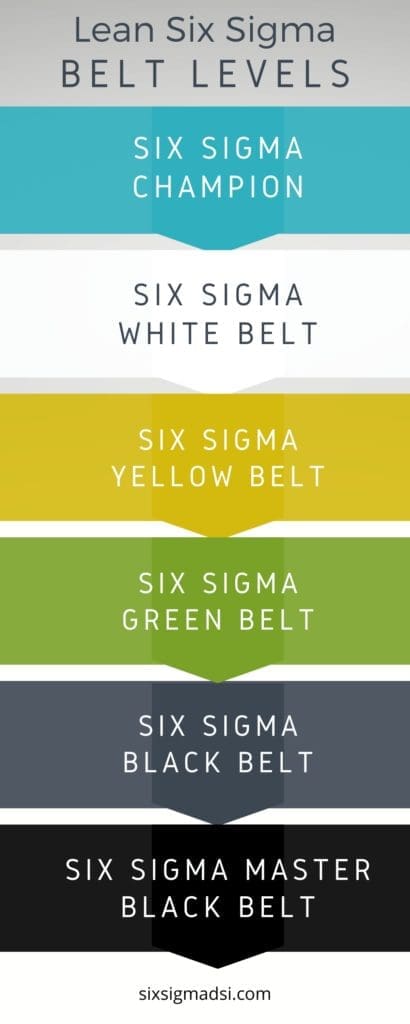Table of contents
Lean Six Sigma Green Belt Salary
You’ll see that the different options available for Six Sigma certification are classified by belt ranking, similar to how belts are ranked in martial arts. The belts are ranked as follows: White belt, Yellow belt, Green belt, Black belt, and Master black belt. While there are two more belts to reach the highest level, greenbelt holders are Lean Six Sigma testing experts that meet the requirements and are eligible to earn a Six Sigma Green Belt Salary at their jobs.
Six Sigma Green Belt Certification: Value for Money
Many professionals consider salary when deciding on a career or pursuing further education. Consider the earning potential requirements before deciding to earn your Six Sigma Green Belt. Salary.com reports that those who have earned their green belt certification will earn between $88,000 and $114,600 per year.
Understanding the Lean Six Sigma certification process
Lean is one of the many Six Sigma certifications that are managed by the Council for Six Sigma Certification. The Lean Six Sigma certification is made up of four belts: white, yellow, and green.
Professionals may choose to pursue the Lean Six Sigma certification as a stand-alone path or as part of a larger Six Sigma journey. CSSC recommends that all professionals undergo Six Sigma training. Those working in public, defense, or military sectors are encouraged to pursue Lean Six Sigma Certification.
The CSSC offers the White Belt certification for free. The Six Sigma GreenBelt is available in Standard and Advanced testing levels after completing the Yellow Belt.
Professionals with the Lean Six Sigma Master Black Belt have demonstrated mastery of all Six Sigma bodies of Knowledge. The professional has also completed a project utilizing either the DMAIC (define, measure analyze, improve, and control) or DMADV (define, measure analyze, design, and verify) methodologies. They also have demonstrated skills in managing teams, leading others, and managing the dynamics of collaboration.
Also Read: What is a Lean Six Sigma Master Black Belt?
Lean Six Sigma Green Belt Possible Job Roles and Requirements
Lean Six Sigma GreenBelt certifications (LSSGBs) will test to give you the skills to improve business processes. This is why many businesses value this skill.
A Lean Six Sigma Green Belt certificate can open up a variety of exciting and testing job opportunities, including:
- Quality Systems ManagerYou can also find out more about the A-Team here. Quality manager It is the responsibility of the team leader to monitor production processes and ensure that all members follow industry and company standards. They can also implement and maintain quality control systems.
- Quality EngineerQuality engineers are a vital part of any Quality assurance (QA) They are responsible for creating and fixing problems they discover. They work with customers, suppliers, manufacturing teams, and design teams. This role is often referred to by the terms QA engineer or QC engineer.
- Quality SupervisorQuality supervisors are typically responsible for leading QA teams through the entire production process. They are responsible for overseeing quality control and quality management systems, as well as managing the customer experience and identifying protocols to ensure a safe working environment. The quality supervisors provide reports that include metrics on the quality of products and services.
- Quality AnalystThe Quality Analyst (or QA analyst) is responsible for identifying and resolving any problems that may occur. To be successful in this role you need to have problem-solving abilities to identify (and communicate with) errors to other team members. As part of the development team, quality analysts are often involved.
- Quality AuditorThey is responsible for identifying improvement areas and creating a plan of action. They may, for example, determine the areas where more training is needed, fix any defects in existing processes and create new training modules. If needed, they are involved in the auditing process from planning to further audits.

Average Salary Statistics by Country and Industry
The six sigma salary range is dependent on factors such as location, industry, and experience. The average salary for a lean six sigma greenbelt test in the United States ranges from approximately 108.400 to the following:
- Salary for Six Sigma Green Belt in India: Around Rs981k per year
- The average Six Sigma Green Belt salary is approximately AU $106k per year
- Six Sigma Green Belt Salary in Canada: About C$79k per year
- Six Sigma Green Belt Salary in the United Kingdom is approximately £42k per annum
Different six-sigma positions have different salaries. A few examples include:
- Quality Engineer: $77,261 per year
- Process Engineer: $84,136 per year
- Manufacturing Engineer: $79 739 per annum
- Production Supervisor: $65,556 per year
- Senior quality engineer: $105 152 per annum
- Employees of the Continuous Improvement Manager: $115 796 per year
Lean Six Sigma Belts
Anyone who can master the Lean Six Sigma method and apply it efficiently is valuable for any business. Each of the four-belt colors represents a different level of success. As you gain competence, your chances of being a valuable member of the organization increase.
1. White Belt
The White Belt is a free certification. White Belts do not participate in Lean Six Sigma projects. White Belt Certification is a basic understanding of the process that will not have a significant impact on a person’s earning potential.
Lean Six Sigma White Belt Certified by the Council for Six Sigma Certification is someone who understands Six Sigma Methodology.
The White Belt Certification demonstrates a person’s knowledge of the discipline, its history, and its framework. This information will give you an idea of the people involved in Six Sigma implementation and their roles in a company.
You can get the Lean Six Sigma White Belt credential in two different ways:
- Individuals who believe that they have a good understanding of the content of the “Body of Knowledge”, for White Belt Certification, may take the standard comprehensive exam.
- If you are using a study guide for free, either on your own or with the help of a training institution, it is possible to take short tests as you progress through each topic.
2. Yellow Belt
Yellow Belts are employees who have been given basic instruction on Six Sigma quality improvement techniques and participate in related initiatives.
The person is a Lean Six Sigma expert but does not run projects alone. They are usually tasked with creating process mapping to aid Six Sigma initiatives. A Yellow Belt certified professional is a key member of a team or subject matter expert (SME) in at least one project.
Employees who have reached the Yellow Belt status may be asked to manage less important process improvement projects using the PDCA methodology (Plan, Do, Check, Act). These projects are usually advanced from the Yellow Belt to Green Belt or Black Belt. At these levels, the DMAIC method and statistical process control are used to achieve the greatest cost savings. There are two certification paths, similar to the white-belt category.
3. Green Belts
Six Sigma Green Belts work closely with Black Belts, and they are in charge of the majority of Six Sigma greenbelt data collection testing. Green Belts often have additional duties in their organizations. This certification belt is divided into two different levels:
- StandardThe individual has a thorough understanding of problem-solving skills, with a focus on the DMAIC model. The Green Belt can then focus on specific, well-defined Six Sigma projects, requiring less effort than the Black Belt which is fully committed to Six Sigma throughout the organization.
- Level IIThis is the Advanced Level certification. A Standard Green Belt Certification must be obtained to apply. There is no exam. The team member is required to present a Six Sigma project that they actively participated in, using the DMAIC/DMADV technique.
4. Black Belts
They keep the team on track in order to meet deadlines and objectives. They are responsible for project management and defining the scope of the Six Sigma project. During a Six Sigma enterprise-wide implementation, a number of concerns and issues can arise. Experts such as Master Black Belts can help teams solve problems and provide practical solutions. There are many levels of certification for this belt, including:
- Standard A Lean Six Sigma Black Belt testing certified through the Council for Six Sigma Certification has a thorough knowledge of the Six Sigma Body of Knowledge. This professional is also well-versed in Six Sigma practices and theories (such as the supporting components and tools).
- Level IIThis certificate is for professionals at advanced levels. The candidate must be able to demonstrate that they have mastered all Six Sigma Body of Knowledge by completing a DMAIC project or DMADV. The Black Belt Certification II demonstrates team management skills, group dynamics, and the ability to assign roles and duties effectively to team members. It demonstrates a high level of awareness of the DMAIC Model, a fundamental understanding of lean enterprise principles, and the capability to quickly identify “non-value-added” processes.
- Level II: The Council for Six Sigma Certification certification of Six Sigma Black Belt Level II is required to apply for the Certification. The certification is similar to Level II, but the most important difference is the complexity of the projects.
- Master Exam criteria and project criteria are part of the formal requirements to obtain the CSSC Lean Six Sigma Master Black Belt certification. The test consists of 150 questions and is open-book. The candidate who passes the test with a minimum score must then submit three completed Six Sigma projects using DMAIC or DMADV. The projects submitted must be completely different from those submitted to Six Sigma Black Belt Level II and III Certification.

Ready to become a Six Sigma Green Belt Professional?
Leave a comment down below! We can help.



















